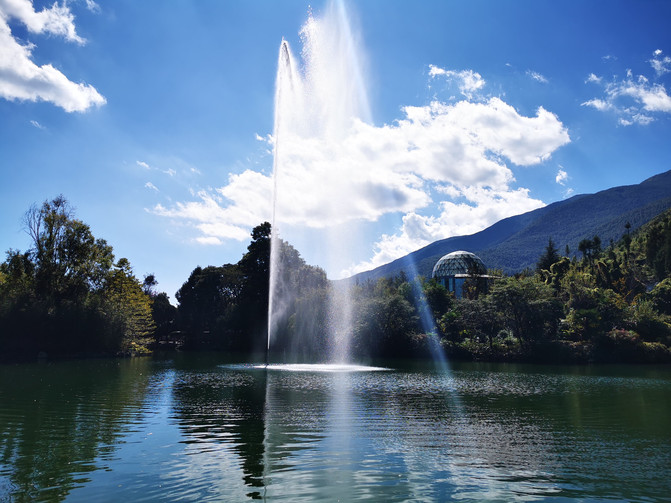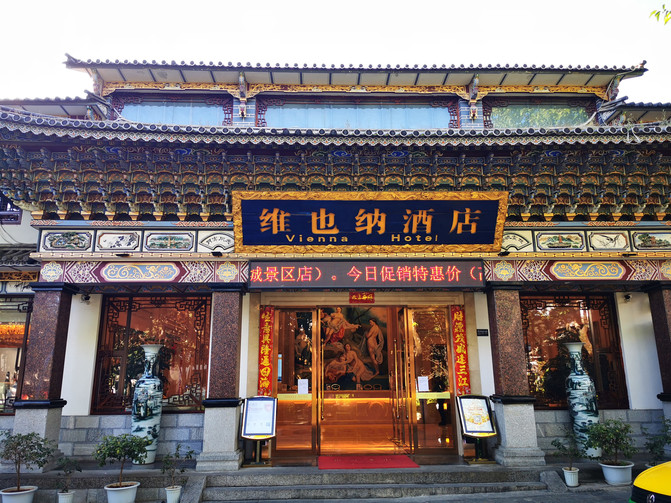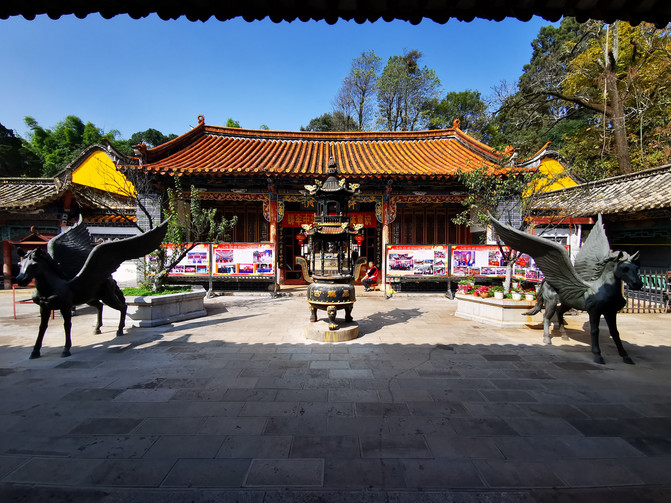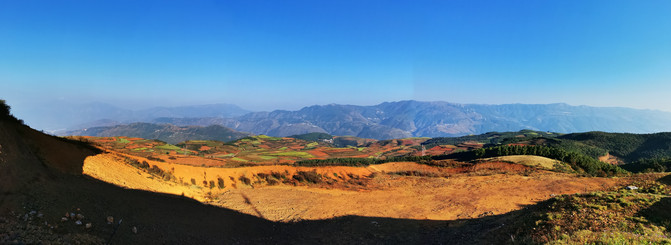A 51-day self-driving autumn tour of Yunguichuan in 2020:(8) Dali Weishan, Chuxiong, Kunming Dongchuan
The 51-day self-driving autumn tour of Yunguichuan in 2020 is divided into 10 chapters:
(1)--Zhijiang Maotai Town Chishui Luzhou Zigong Chapter.
(2)--Chengdu Dujiangyan
(3)--Malkang Jinchuan Danba Xindu Bridge, Li County, Wenchuan
(4)--Xinduqiao, Yajiang, Litang, Daocheng
(5)--Daocheng Yading Chapter
(6)--Shangri-La Lijiang Chapter
(7)--Jianchuan Chapter
This is (8)--Dali Weishan Chuxiong Kunming Dongchuan Chapter
(9)--Duyun, Ziyun, Panzhou, Southwest Guizhou
(10)--Quzhou, Fuzhou, Southeast Guizhou
This self-driving tour, from October 9 to November 28, lasted 51 days and traveled 8780 kilometers.
Starting from Shanghai, pass through Quzhou, Zhejiang, Zhuzhou, Jiangxi, Zhijiang, Hunan, Maotai Town, Chishui, Guizhou, Luzhou, Zigong, Chengdu, Dujiangyan, Wenchuan, Li County, Maerkang, Jinchuan, Danba, Xinduqiao, Litang, Daocheng, Yunnan, Shangri-La, Lijiang, Jianchuan, Shaxi, Dali, Weishan, Chuxiong, Kunming, Dongchuan, Guizhou, Panzhou, Southwest, Ziyun, Duyun, Guizhou, and Southeast, passing through Loudi, Hunan, Fuzhou, Jiangxi, Quzhou, Zhejiang, and then back to Shanghai.
Day 28, November 5, from Shaxi Ancient Town to Shuanglang Ancient Town
4. Double corridors: the best scenic spot to view the Erhai Lake. Yuji Island, Nanzhao Style Island, 1985 meters above sea level.
Stay at Yunqibishe Seaview Courtyard Inn, an inn facing the sea:


After checking in, I sat by the seaside of the inn, facing the sea, drank Yunnan coffee, watched the clouds rolling and the waves rolling until the sun went down, and then went out for dinner:















Nanzhao Style Island, you have to go by boat:


Eat fish hot pot for dinner, and you can resume drinking:



I am full of wine and food, and look at the night of the ancient town:

















Day 29, November 6, Dali, 10:40--16: 15
Morning in Erhai Lake:









Hotel Breakfast:

Visit the double corridor first.







Yang Liping's Moon Palace:

















Yang Liping's Sun Palace:




From Shuanglang Ancient Town to Butterfly Spring:
5. Butterfly Spring:
4A, ticket is 15 yuan, and shuttle bus round-trip is 20 yuan.
The second time I came to play, I saw a pool of clear water under a crooked tree. A place famous for the movie "Five Golden Flowers".
The market at the exit made everyone go around eight or nine times. It was really disgusting. There are many people selling and renting Bai clothes, photography, food, etc. in the scenic area, and they "take the trouble" to recommend them.











Brother A Peng and Jin Hua, brother and sister have a deep friendship:


















6. Xizhou Ancient Town:

















7. Three pagodas of Chongsheng Temple:
5A, ticket is 37 yuan. This is the second time to play.





The tower is an even number, which means equality between men and women.






















Stay in Vienna Dali Ancient City Scenic Area Store. There was a power outage at night, but fortunately the hotel generated electricity.

Day 30, November 7, Dali, 9:30--
8. Dali Ancient City: 4A
This is the second time to play.
There are too many people in the ancient city of Dali, more people than the ancient city of Lijiang.
Inside the ancient city: Ancient City Wall, Foreign Street, Dali City Museum, Wuhualou, Renmin Road, Wumiao Hui (now the antique market)

















































Outside the ancient city:
One Tower (Hongsheng Temple, closed).
Yuan Shizu Pingyun Monument (not opened, but it was photographed through the crack of the door):



9. Nanzhao Dehua Monument:









10. Xiaguan:
Dali Prefecture Museum


































Go from Xiaguan to Weishan County.
Stay at Yunzhishang Hotel in Weishan County.
Weishan County:
The birthplace of the ancient Nanzhao country 1300 years ago, was built in the 22nd year of Hongwu of the Ming Dynasty. In 1389, the ancient city maintained the chessboard pattern when it was built more than 600 years ago. It is a relatively well-preserved ancient building complex of the Ming and Qing Dynasties in China.
Gongchen Tower, Xinggong Tower, Menghua Hometown, Jinshi Archway, Qunli Gate, Mengyang Park, Yuanjue Temple (the white pagoda in front of the gate is the Ming Dynasty), Confucian Temple.
Weishan County is not on the main road, has few tourists and is more authentic.













































Day 31, November 8, Weishan County to Chuxiong, 8:40-16:15
From Weishan County to Weibao Mountain: 14 kilometers, 0:25
Weibao Mountain:
Tickets are 18 yuan. 9:10--11:50
One of the 14 famous Taoist mountains in the country has nearly 20 Taoist temples, most of which are buildings dating from the early Qing Dynasty and have a simple atmosphere. This is also the birthplace of Nanzhao. The altitude is 2230 meters.
We only visited the Yuhuangge area, where nearly half of the Taoist temples were concentrated, about a 20-minute walk from the gate.
It seemed that there were only the two of us, and we met less than 20 people on the road. The birds chirped constantly in my ears. It is a quiet immortal mountain.


























Guan Gong:






































After questioning the Taoist priest, the "stone contains green" had been put away for protection. The "Laojun Meditation Stone" and the "Laojun Supporting Stone" were not in the temple. I searched outside the temple but could not find them.


















There are a total of 10 murals above the head of Taishang Laojun in the main hall.
The main hall was very dark and ordinary people couldn't notice it. You need Huawei night view mode to take pictures.









I went to Changchun Cave and returned after walking for a long time.

From Weibao Mountain to Chuxiong City: 226 kilometers, standard 4:00. Actual 11:50-16:15






Stay at Chuxiong Yuhua Hotel. The altitude is 1775 meters.
Day 32, November 9, Chuxiong City 10:00-17:30
Chuxiong is a peaceful and quiet city, located between Kunming and Dali and Lijiang. There are not many scenic spots in the urban area. The famous Yuanmou Soil Forest and Dinosaur Valley are all in suburban counties. It's embarrassing. But it is said that the house price here is only over 5000 yuan.
Chuxiong Prefecture Museum, 4A: Closed on Mondays
Futa Park: Known as the first Futa in China.



















Yi Ancient Town, 4A:
A large-scale cultural tourism real estate project with ancient buildings as the platform and Yi culture as the soul. The main attractions include Wangjiang Tower, Taohua Creek, Deyun Square, Ancient Stage, Miyilu Square, Meige Square, Huohuo Square, Yi Tribe, Tusi Mansion, etc.
There are many shops, few tourists, and it is very quiet. After wandering around blindly, I have been here.















From Chuxiong to Kunming City: 147 kilometers, standard 2:08
Stayed at Daguan Branch on Xiyuan Road, Vienna.
Daguan Park (near Second Ring South Road):
Tickets are 10 yuan. This is the 3rd time to visit.
China's first long couplet, with a total of 180 words, was written by Sun Yanweng, a famous scholar in Yunnan during the Qing Dynasty, summarizing Kunming's natural and historical landscape.




























Guandu Ancient Town (8 kilometers south of Kunming).













































Day 33, November 10, Kunming
When I arrived in Kunming, I saw the haze that I had not seen in many days again, and the air quality was 90. I originally wanted to go to Longmen in the West Mountain again and stand on the cliff to watch Dianchi Lake, but I couldn't see it after going there, so I had to avoid it.
The weather in Yunnan is cool in the morning and evening, and very hot at noon. It is 20 degrees, and the hot sunshine seems to be in Guangdong.
I originally wanted to go to Xishuangbanna, which is a hotter place. Better find another suitable time to go.
Stay at Kunming Vienna Beijing Road Chuanxin Drum Tower Subway Station Branch.

1. Ganzhu Temple: Parking 5
It was built in the Yuan Dynasty and was the first temple to be introduced to Yunnan by the Central Plains Buddhist Zen Buddhism. The existing temple was rebuilt during the Guangxu period of the Qing Dynasty (1885-1891). The famous 500 Arhats statue was the result of that time. It took seven years to complete this masterpiece by Li Guangxiu, a Sichuan folk sculptor in the Qing Dynasty, and three apprentices.
Ganzhu Temple is 18 kilometers away from the urban area. It runs from the west of Kunming to Heilinpu, turns to Yuan and winds up the mountainside for 3 kilometers to reach Ganzhu Temple. The trees here are lush and the flowing springs are gurgling. It used to be the "Six Scenes of Dianyang" and was known as the "Jade Case and Clear Mist" in Central Yunnan.
The ancient temple is built along the mountain and is divided into three floors: the Daxiong Hall, Tiantai Lai Pavilion, Fanyin Pavilion, etc. As soon as we entered the door, two tall Yuan Dynasty peacock fir trees stood facing us. There are many plaques and couplets in front of the Daxiong Hall, which are amazing. This temple was built by brothers Gao Guang and Gao Zhi from Shanchan Prefecture (Kunming) in Dali State. It is said that when they hunted here, they saw an eminent monk sticking his staff in the ground, and no matter how hard they tried, they could not move it. The next day, it turned into a bamboo forest, thinking that Baoshan had spirits, so he built a temple on the spot and named it "Yuzhu."
Luohan Characteristics
The five hundred arhats carvings in the temple are of different shapes, and the expressions of joy, anger, sorrow, and joy are all the same, making it a spectacle. Whether viewed from afar or close, the human proportions, muscles and bones, and clothing patterns of these arhat statues are generally similar to ordinary people, making them amiable. The sculpture also uses various techniques such as hollow out and round carving to three-dimensionally present the intimate relationship between the human body, the atmosphere and the collocation of objects.
The mineral pigments used on the statue have an everlasting history. The gold-plated clothing is made of pure gold. The pieces are thin and beautiful, glued and hot, and they are still shining today. Among the five hundred clay sculptures of Arhats in many famous temples in China, the art of Arhat in the Temple is the highest and is known as the "Pearl of Oriental Sculpture."
The five hundred arhats of the Wuzhu Temple are displayed on the two walls of the Daxiong Hall (68 statues), Tiantai Lai Pavilion (216 statues), and Fanyin Pavilion (216 statues). They are divided into upper, middle, lower and lower floors. The upper and lower floors are mostly sitting statues, and the middle floor is mostly standing statues. The arrangement of the statues is symmetrical, such as the dragon on the left, the tiger on the right; the cloud on the left, the fog on the right, and the fog on the right, etc. These arhats are in a variety of shapes and fun, with varying postures and demeanor, and different expressions and postures. Clothing and decoration differ according to the character's age, personality characteristics and environment. Although the five hundred arhats each present a wonderful appearance, they generally include two categories in terms of creative techniques.
































2. Black Dragon Pool Park:
Located in the northern suburbs of Kunming. Tickets are 7.5 yuan.
The park can be divided into three parts: the lower viewing area, namely Black Dragon Palace, the upper viewing area, namely Longquan Temple, and the garden scenic area.
There are three main features of the Shangxia viewing area:
First, the water in the pond is strange.
Black Dragon Pool has two ponds, deep and deep. Both ponds are built with stone railings surrounding the ponds, with a narrow stone bridge in the middle; the stone railings were first built in the fourth year of Jingtai in the Ming Dynasty, that is, in 1454 AD.
The deep pool is the Black Dragon Pool, also known as the Qingshuitan. It is circular and covers an area of 600 square meters. Spring water gushed out from the bottom of the pool and was relatively clear, with a depth of 15 meters. The shallow pool is located to the northeast of the deep pool. The spring water is slightly yellow and is called Hunshuitan. It covers an area of 2600 square meters and has a water depth of 0.5 meters.
There are two magical things about the Black Dragon Pool. The two ponds are only a few steps apart, but the water colors are completely different. One is clear and the other is muddy, one is deep and the other is shallow, like the Taoist "Tai Chi Diagram" of Yin and Yang; the two springs are connected, but the fish do not cross each other, forming a strange scene and spectacle of "the two waters intersect, but the fish do not interact", which attracts tourists to sigh and inquire about it, but they can not understand: nature is really wonderful.
The second is the remains of ancient buildings, demonstrating the strong Taoist cultural atmosphere.
Before entering Shangguan, you will first see a stone archway, with a plaque of "Pine Wind and Water Moon" written on the front of the square eyebrow. The couplet: There is no worldly benefit in seclusion in the mountains, and there is no joy in living in the fairy cave. It means to live quietly in the mountains, without worldly worries, live quietly in the fairy cave, and be willing to obey your true nature. -- It simply expresses the realm of Taoism's pursuit of becoming an immortal, transcending the secular world, not being tired of things, and being as quiet as living in an immortal place.
On the back is the plaque "Tao Tao and Nature", and the couplet:
Tao lives one life, two life, three life, three life, all things,
People govern the earth, the earth, the law, the law
While reading it, I felt the depth of Taoism, which basically means that human beings must abide by the laws of nature and not violate the rules of heaven. Only then can heaven, earth and man live in harmony, maintain balance, and achieve the unity of nature and nature. -- Use thimble techniques and wonderful language to express the profound philosophical thoughts of Taoism.
The two couplets express the essence of Taoism's thoughts: the Tao of nature, and the unity of man and nature.
The gate to enter Longquan Temple is an archway with a plaque with gold characters "Ziji Xuandu" on a red background. Above this plaque is the three words "Longquan Temple" in gold characters on a blue background, and on both sides are "Tianqing" and "Ditai". Gate.
Longquan Temple is a Taoist building complex built in the Yuan Dynasty.
Longquan Temple is divided into 5 entrances and 13 large and small courtyards, including Thunder Temple, Arctic Temple, Jade Emperor Temple, Sanqing Temple, Changchun Real Man Temple and Tongmiao Real Man Temple. The entire building complex rises layer by layer from south to north along the mountain: the first floor of the Purple Pole Xuandu Gate, the second floor of the Thunder Temple, the third floor of the North Pole Hall (now the Ancestral Hall, with the Doumu Pavilion on the side), the fourth floor of the Jade Emperor Hall, and the fifth floor of the Sanqing Hall; all the halls have side halls and wing rooms.
The multi-layered ascending structure should reflect the depth of Taoism, and the meaning that religious believers require climbing and persistence.
There is a couplet in the Ancestral Hall: The universe is the invisible path that runs through ancient and modern times. Ask who has created chaos. Yin and Yang have the original nature and virtue to influence heaven and earth. Let me recreate the universe. -- Express the confidence of Taoism to your heart's content.
Not only does the building complex have a strong Taoist cultural color, but the sound of wooden fish and copper chimes set off the unique chanting sound of scriptures, filling the entire Shangguan with a tranquil atmosphere.
The ancient building complex next to Longtan is called the "Black Dragon Palace", commonly known as Xiaguan. It was built in 1394 AD in the 27th year of Hongwu of the Ming Dynasty. In 1454 AD in the fourth year of Jingtai of the Ming Dynasty, it was inherited as the Mu family of Duke of Guizhou and rebuilt the Black Dragon Palace.
The Black Dragon Palace has three entrances and four courtyards, with lush green trees and simple and elegant. The main hall is for the Dragon King, and the auxiliary hall is for water supply people and other statues. In 1966, during the Cultural Revolution, the statue was completely destroyed. On the wall of the main hall of the Dragon Palace is an inscription of Fan Chengxun, the governor of Yungui, during the Kangxi period of the Qing Dynasty, visiting the Black Dragon Pool. On November 3, 2000, a large number of goldenfish swam out of the Black Dragon Pool. Kunming news media reported that it attracted widespread attention from the society. The Black Dragon Palace was restored as a historic tourist area.

























Song Bai's picture exceeds 10M and cannot be uploaded.













Cuihu Park:




















Yunnan Jianwu Hall:




Jinma Biji Workshop.









Dinner:

Day 34, November 11, from Kunming to Dongchuan Red Soil, 140 kilometers, 2:55
Dongchuan Red Soil:
4A, 1280 meters
Experts believe that it is the most imposing red land in the world except Rio de Janeiro, Brazil, and is more magnificent than Brazil.
Located in a warm and humid environment, the iron in the soil is slowly deposited through oxidation, gradually forming a dazzling color.
Focusing on more than 20 square kilometers around Huagou Village and Huashitou Village in Hongtudi Town, there are many landscapes such as Qicaipo, Luoxiagou, Laolongshu, Jinxiu Garden, Luosiwan, Muyuao, and Guodi Pond.




























































































Stay at Hongtu Summer Hotel:


Dinner: Walking old hen


This is my 49th travel note. If you like it, please like it!
I hope it helps tourists!
Previous Article:Yunnan Dali
Next Article:After a year, he returned to Dali. New story, new self (attached travel guide)
